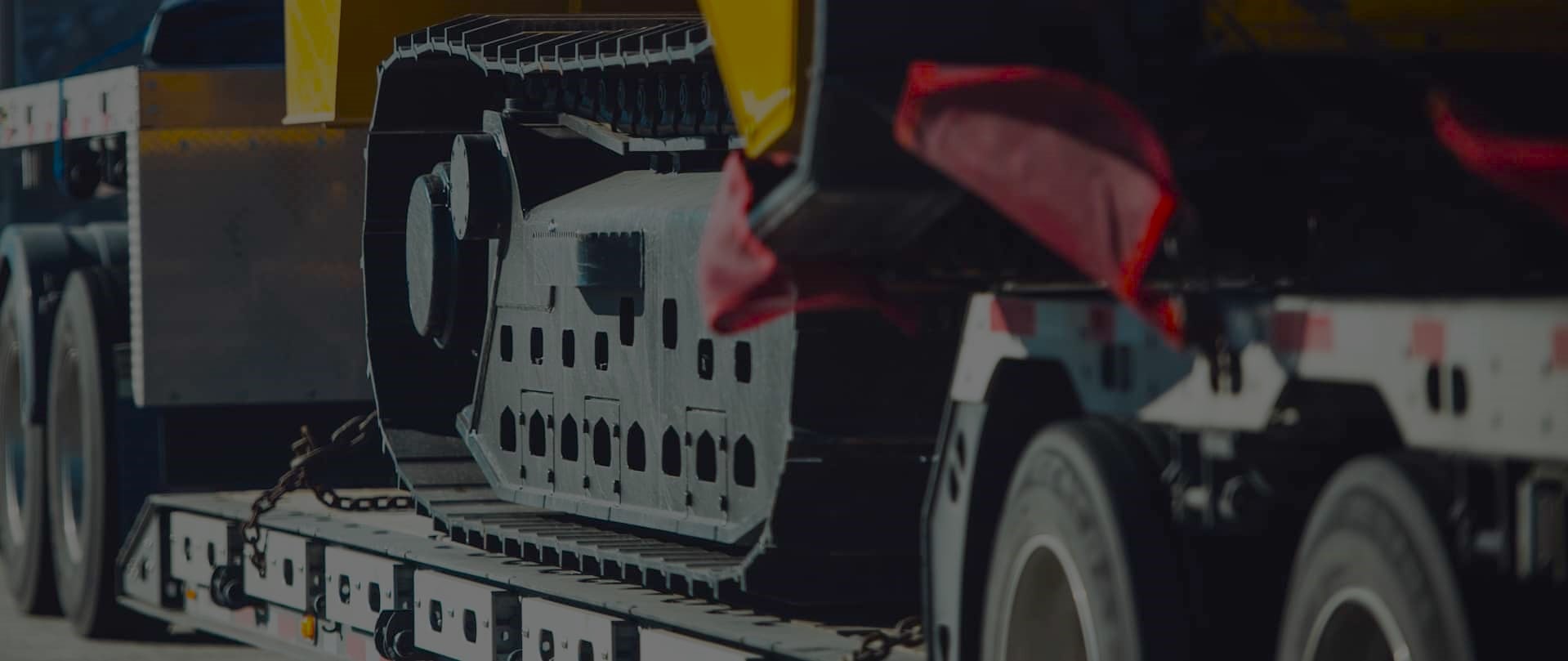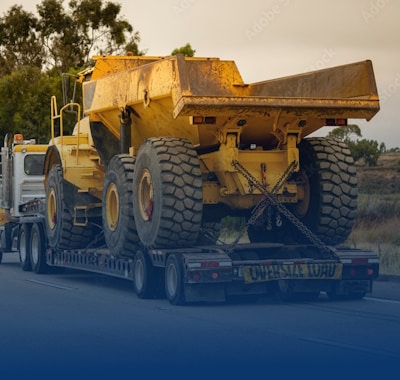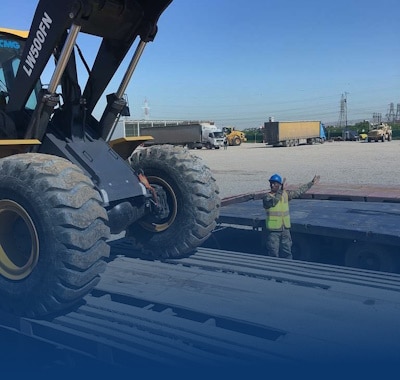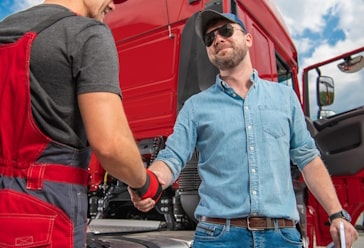Safely Transport Heavy Equipment: Tips to Prepare
Freedom Heavy Haul can offer expedited Pickup and Delivery for any size shipment anywhere in the USA. Contact us today for No Hassle, No Pressure Pricing.
Moving heavy machinery is a complex process that requires expertise, planning, and the right tools. At our company, we specialize in heavy equipment transport, ensuring every move is safe, efficient, and cost-effective. Proper planning is essential to reduce risks and avoid damage during transit.
In the U.S., equipment transport is governed by specific regulations to maintain safety and efficiency. Understanding these rules is crucial for a smooth process. We focus on clear documentation, secure loading, and route optimization to meet these standards.
Our team emphasizes the importance of inspections and securement before transport. Partnering with reliable professionals ensures your heavy machinery arrives safely and on time. Learn more about our best practices for safe transport to minimize downtime and maximize efficiency.
By following these steps, we provide a seamless experience for our clients. Stay tuned as we dive deeper into regulatory requirements and preparation methods in the upcoming sections.
Understanding Heavy Equipment Transportation Regulations
Navigating the regulations for moving heavy machinery is essential for compliance. Federal and state laws ensure safety and efficiency during transportation. Understanding these rules helps avoid penalties and reduces risk.
Federal and State Legal Requirements
Federal guidelines, such as 49 CFR 393.130, outline specific standards for vehicle securement. These rules mandate proper tiedown procedures for crawler tracks and wheels. State-level permits are often required for oversize or overweight loads.
For example, maximum allowable widths and weights vary by state. Compliance with these requirements ensures smooth transport across state lines. We specialize in navigating these complex regulations to keep your equipment transport hassle-free.
Classification of Heavy Machinery
Heavy machinery is classified based on weight and design. Excavators and bulldozers, for instance, fall into specific categories. These classifications determine the regulations that apply during transportation.
Understanding these categories helps in planning the loading and route for your heavy machinery. Proper classification also ensures compliance with federal and state laws.
Obtaining Necessary Permits
Moving oversize or overweight loads requires specific permits. Each state has its own application process and fees. These permits ensure that your load meets legal standards.
We handle the entire process, from documentation to approvals. Our experience ensures that your equipment transport is compliant and efficient.
Adhering to these regulations minimizes the risk of accidents and damage. Thorough inspections and clear documentation are key to maintaining safety during transportation.
Essential Pre-Transportation Safety Checks
Pre-transportation checks are a critical step in minimizing risks and ensuring compliance. Proper inspection of heavy equipment reduces the chance of damage and ensures a smooth transport process. At our company, we prioritize safety and follow a systematic approach to pre-trip assessments.
Equipment Inspection and Documentation
Thorough inspections begin with verifying key components. Check tire conditions, brake functionality, and the integrity of tie-down points. These steps help identify potential hazards before transit begins.
Documenting the condition of your equipment is equally important. Take photographs and videos to create a clear record. This documentation builds trust and ensures compliance with state and FMCSA regulations.
Risk assessments play a vital role in identifying issues early. A detailed process ensures that all aspects, from loading to trailer securement, are addressed. This minimizes the risk of accidents and protects your load.
Our team uses industry-specific checklists to ensure nothing is overlooked. We verify weight distribution and secure heavy components to prevent shifting during transportation. This level of planning and knowledge sets us apart.
By following these steps, we ensure your heavy equipment arrives safely and on time. Trust our expertise to handle every detail of your equipment transport needs.
How to Prepare Heavy Equipment for Safe Transportation
Ensuring the safe transit of heavy machinery starts with meticulous preparation. Proper cleaning, securement, and attachment preparation are critical to minimizing damage and ensuring a smooth transportation process. We follow a systematic approach to guarantee your equipment arrives in perfect condition.
Cleaning and Securing Equipment
Cleaning heavy equipment removes debris that could cause issues during loading or transit. Use high-pressure washers to clean all surfaces, including hard-to-reach areas. Inspect for loose parts and secure them to prevent shifts during transport.
Follow manufacturer guidelines for proper inspection and securement. Check tire pressure, brake systems, and hydraulic lines. Document the condition of your equipment with photos and videos for reference.
Preparing Attachments and Accessories
Detach accessories like blades or buckets if possible. Secure these items separately to avoid damage during transportation. Use protective covers to shield sharp edges and delicate components.
Coordinate with your transportation partner to ensure all attachments meet loading requirements. Our team provides expert guidance to streamline this process and ensure compliance with safety standards.
| Step | Action | Purpose |
|---|---|---|
| 1 | Clean all surfaces | Remove debris and improve safety |
| 2 | Secure loose parts | Prevent shifts during transit |
| 3 | Detach accessories | Avoid damage and ensure compliance |
| 4 | Document condition | Build trust and maintain records |
By following these steps, we ensure your heavy equipment is ready for transport. Our experience and attention to detail make us the trusted choice for equipment transport needs.
Planning and Scheduling Your Heavy Equipment Move
Effective planning is the backbone of successful heavy equipment transport. It ensures every step, from loading to delivery, is executed smoothly. At our company, we prioritize meticulous planning to minimize risk and maximize efficiency.
Route Planning and Timing Considerations
Early route planning is essential to avoid high-traffic areas and potential hazards. We analyze transportation paths to ensure compliance with regulations and optimize safety. Proper timing also accounts for loading windows, permit processing, and transit delays.
As industry experts, we understand the importance of scheduling ample time for each phase of the process. This includes planned downtime during transit to ensure safer and more efficient operations. Our experience allows us to anticipate challenges and prepare contingencies.
“A well-planned route reduces the likelihood of accidents and ensures timely delivery.”
Gathering multiple quotes is another critical step. It helps compare costs and services, ensuring you receive the best value. Our team provides transparent pricing and detailed timelines to meet your needs.
| Step | Action | Benefit |
|---|---|---|
| 1 | Plan the route | Avoid hazards and optimize safety |
| 2 | Schedule ample time | Reduce stress and ensure efficiency |
| 3 | Gather multiple quotes | Compare costs and services |
| 4 | Prepare contingencies | Mitigate unexpected issues |
By focusing on detailed planning and scheduling, we ensure your heavy equipment arrives safely and on time. Trust our experience to handle every aspect of your equipment transport needs. For more insights, explore our guide on transporting large machinery with permits and route.
Securing Loads and Assessing Transport Equipment Capabilities
Proper load securement is a cornerstone of safe and efficient transport. Ensuring your heavy equipment is securely fastened minimizes risk and prevents damage during transit. We follow industry-best practices to guarantee your load arrives safely and on time.
Proper Load Securement Techniques
Using approved methods like chains, tie-downs, and blocking ensures your equipment stays in place. These techniques prevent shifting, which can lead to accidents or damage. Our team rigorously inspects each load to confirm securement meets federal and state standards.
For example, we use specialized tie-downs for crawler tracks and wheels. This approach ensures compliance with 49 CFR 393.130 regulations. Proper securement also reduces the risk of delays and ensures timely delivery.
Trailer and Truck Hauling Capacities
Matching your trailer or truck to the weight equipment specifications is essential. We evaluate hauling capacities to ensure your vehicle can handle the load. This includes verifying weight ratings and trailer dimensions.
Federal and state limits dictate when special permits or escort vehicles are required. Our experience ensures compliance with these regulations. We also conduct internal inspections to match loads with optimal transport equipment.
“Proper securement and vehicle matching are key to reducing risks and ensuring safety.”
For more insights, explore our guide on loading un-driveable equipment to enhance your transportation process.
Choosing the Right Transportation Partner and Trailer for Your Equipment
Selecting the right partner for transporting heavy machinery is crucial for success. A reliable company ensures your equipment arrives safely and on time. We focus on safety, experience, and proper planning heavy equipment moves to minimize risk and maximize efficiency.
Evaluating Experience and Safety Standards
When choosing a transportation partner, experience matters. Look for a company with a proven track record in handling heavy equipment. Verify their compliance with federal and state regulations to ensure a smooth process.
Safety is non-negotiable. Ensure the company follows strict safety protocols and has proper insurance coverage. This protects your load from potential damage during transit. We prioritize safety at every step, from planning heavy equipment moves to final delivery.
Comparing quotes and reviewing past performance helps identify the best partner. Clear communication and collaborative planning ensure your equipment transport is seamless and efficient.
Trailer Types and Their Benefits
Choosing the right trailer is equally important. Different trailer types offer unique benefits for various heavy machinery needs. Here’s a breakdown of common options:
| Trailer Type | Benefits |
|---|---|
| Flatbed | Versatile and ideal for standard loads |
| Step-Deck | Lower deck height for taller equipment |
| Low-Loader | Designed for oversized and heavy equipment |
| RGN (Removable Gooseneck) | Excellent for transporting large, heavy machinery |
Our team evaluates your equipment and recommends the best trailer for your needs. This ensures your load is secure and compliant with transportation standards.
By focusing on safety, experience, and the right trailer, we guarantee your heavy machinery arrives in perfect condition. Trust us to handle every detail of your equipment transport needs.
Documenting Inspections and Meeting Regulatory Compliance
Accurate record-keeping ensures compliance and minimizes risks during transit. Proper documentation is essential for meeting regulatory standards and protecting your equipment. We follow a systematic approach to ensure every step is thoroughly recorded and compliant with federal and state laws.
Risk Assessments and Pre-Trip Documentation
Comprehensive risk assessments are critical before any transportation process. These evaluations identify potential hazards and ensure all safety measures are in place. We use detailed checklists to verify vehicle conditions, loading procedures, and securement methods.
Documenting inspections with photos and videos creates a reliable record for liability purposes. This practice not only builds trust but also provides a baseline for equipment condition. Our team ensures all records meet FMCSA and state requirements.
“Thorough documentation reduces disputes and ensures compliance with industry standards.”
Regulatory requirements mandate proper documentation for permits, pre-trip checks, and risk evaluations. We use advanced tools for accurate reporting, ensuring your transport process is seamless and compliant. Systematic recording of inspections enhances safety and identifies potential issues early.
Partnering with a reliable company ensures meticulous record-keeping, reducing delays and enhancing efficiency. Our experience in handling heavy equipment transportation guarantees your load arrives safely and on time.
| Step | Action | Benefit |
|---|---|---|
| 1 | Conduct risk assessments | Identify hazards and ensure safety |
| 2 | Document inspections | Create a reliable record for liability |
| 3 | Verify regulatory compliance | Meet federal and state standards |
| 4 | Use pre-trip checklists | Ensure thorough preparation |
By focusing on detailed documentation and compliance, we ensure your heavy equipment arrives in perfect condition. Trust our expertise to handle every aspect of your equipment transport needs.
Final Tips and Next Steps for a Successful Heavy Equipment Move
Successfully moving heavy machinery requires careful attention to detail and adherence to safety standards. Every step, from loading to delivery, must be executed with precision to minimize risk and ensure efficiency. Proper planning, thorough inspections, and secure transport methods are essential to avoid damage and delays.
We emphasize the importance of following regulations and choosing the right vehicle for your load. Detailed route planning and accurate quotes help streamline the process. Partnering with an experienced company ensures your equipment arrives safely and on time.
For more insights, explore our guide on best practices for transporting tracked loaders and skid steers. Trust our expertise to handle every detail of your equipment transportation needs. By following these tips, you can achieve a smooth and successful move with minimal downtime.







